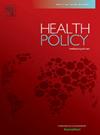The impact of C-level positions on hospital performance: A scoping review of top management team outcomes
IF 3.4
3区 医学
Q1 HEALTH CARE SCIENCES & SERVICES
引用次数: 0
Abstract
Background
As hospitals expand their roles within transforming health systems, their governance structures must adapt to changing demands, with novel leadership structures evolving to meet new challenges.
Objective
This review aims to provide a comprehensive overview on the evidence of the influence of hospital C-level positions on key organisational performance parameters. It maps key concepts from the existing literature relating to hospital performance and leadership and identifies mediators and moderators of top management team impacts based on the Upper-Echelons-Theory.
Methods
The scoping review was conducted according to the Joanna Briggs Institute methodology and Preferred Reporting Items for Systematic Reviews and Meta-Analyses extension for Scoping Reviews, covering studies from 1990 to the present. Eligible studies addressed at least one identifiable hospital C-Suite role and one hospital-wide leadership effect.
Results
Out of 5430 articles identified, 60 were included. The analysis covers seven distinct C-Suite roles and their effects on six performance dimensions: quality of care, structural quality, patient satisfaction, work satisfaction, financial performance, and process efficiency.
Conclusions
The findings suggest that the influence of C-Suite positions on hospital performance is multifaceted, with the Chief Executive Officer’s influence extending beyond financial performance to shaping the quality of care. Additionally, the impact of newer roles such as the Chief Quality Officer, as well as leadership roles like the Chief Medical Officer and Chief Nursing Officer, appear to depend on a collaborative approach and alignment with the Chief Executive Officer. From a policy perspective, the findings emphasise that hospital governance, shaped by regulations, determines key performance indicators and strategic priorities.
c级职位对医院绩效的影响:对最高管理团队成果的范围审查
随着医院在转型卫生系统中的作用不断扩大,其治理结构必须适应不断变化的需求,新的领导结构不断发展,以迎接新的挑战。目的本综述旨在全面概述医院c级职位对关键组织绩效参数影响的证据。它映射了与医院绩效和领导力相关的现有文献中的关键概念,并根据上层理论确定了高层管理团队影响的中介和调节因子。方法根据乔安娜布里格斯研究所的方法和首选报告项目进行范围评价和范围评价扩展的荟萃分析,涵盖1990年至今的研究。合格的研究涉及至少一个可识别的医院C-Suite角色和一个全院范围的领导效应。结果5430篇文献中,60篇被纳入。该分析涵盖了七种不同的高管角色及其对六个绩效维度的影响:护理质量、结构质量、患者满意度、工作满意度、财务绩效和流程效率。研究结果表明,高管职位对医院绩效的影响是多方面的,首席执行官的影响不仅限于财务绩效,还影响到医疗质量。此外,新角色(如首席质量官)以及领导角色(如首席医疗官和首席护理官)的影响似乎取决于合作方法和与首席执行官的一致。从政策角度来看,调查结果强调,受法规影响的医院治理决定了关键绩效指标和战略重点。
本文章由计算机程序翻译,如有差异,请以英文原文为准。
求助全文
约1分钟内获得全文
求助全文
来源期刊

Health Policy
医学-卫生保健
CiteScore
6.40
自引率
6.10%
发文量
157
审稿时长
3-8 weeks
期刊介绍:
Health Policy is intended to be a vehicle for the exploration and discussion of health policy and health system issues and is aimed in particular at enhancing communication between health policy and system researchers, legislators, decision-makers and professionals concerned with developing, implementing, and analysing health policy, health systems and health care reforms, primarily in high-income countries outside the U.S.A.
 求助内容:
求助内容: 应助结果提醒方式:
应助结果提醒方式:


